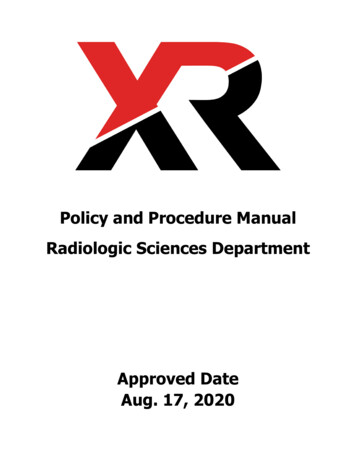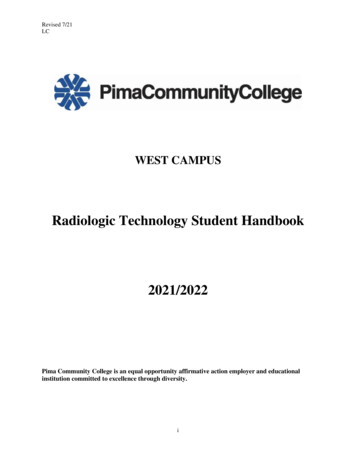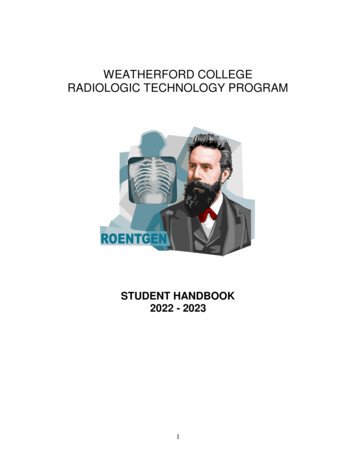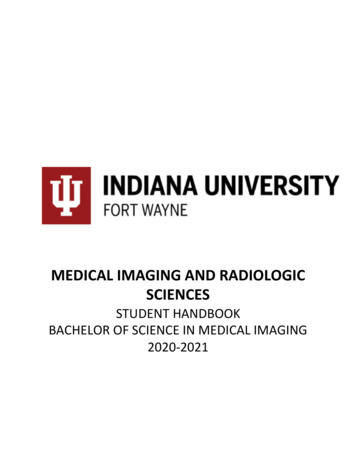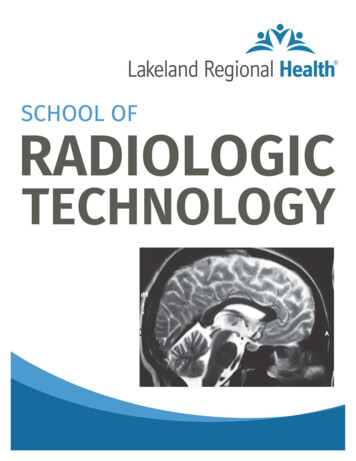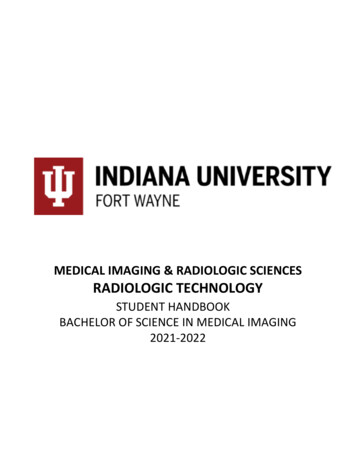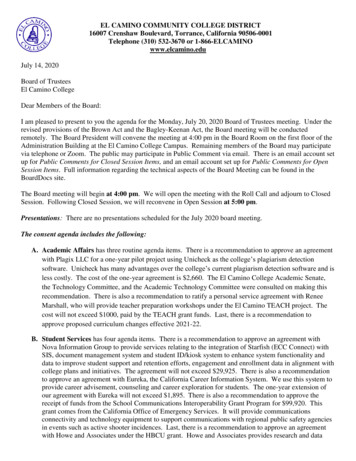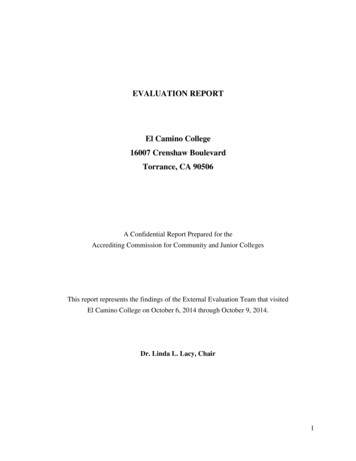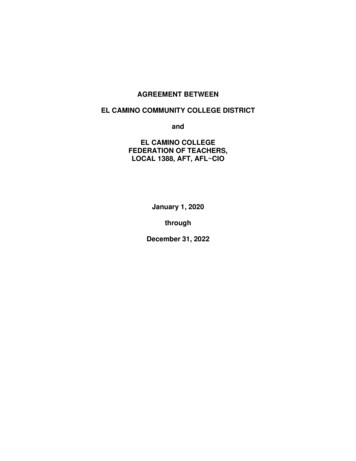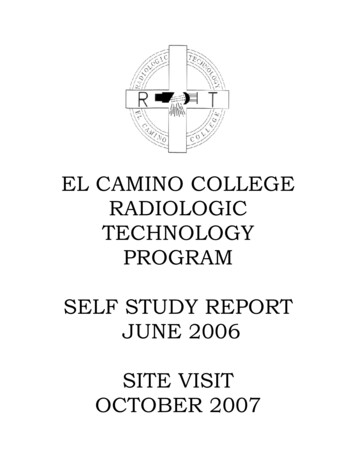
Transcription
EL CAMINO COLLEGERADIOLOGICTECHNOLOGYPROGRAMSELF STUDY REPORTJUNE 2006SITE VISITOCTOBER 2007
JRCERT Self Study Report Prepared by:Dawn N. Charman, M.Ed, RTRadiologic Technology Program Director6/01/06Kelly A. Clark, M.S.R.T.Radiologic Technology Clinical Coordinator6/01/06Report Reviewed by:Dr. Thomas FalloPresident, El Camino College6/01/06Dr. Francisco ArceVice President, Academic Affairs6/01/066/01/06Dr. Charles Irvin DrewInterim Dean, Health Sciences and Athletics
8 YEAR ACCREDITATION!
1.1Does the program have a mission statement that defines the purpose and scope ofthe program?The El Camino College, Radiologic Technology Program’s Mission Statement is as follows:The mission of the Radiologic Technology Program is to prepare wellqualified imaging practitioners who are committed to professional growth andlife long learning, while supporting the highest standards of ethics, patientcare, and technical practice.The Radiologic Technology Program’s mission statement is consistent with the El CaminoCollege mission statement:THE MISSION of El Camino College is to meet the educational needs of our diversecommunity and ensure student success by offering quality, comprehensive educationalopportunities.EL CAMINO COLLEGE is committed to being an open access institution and servingstudents of all ages, cultures and backgrounds.Our exemplary faculty and professional staff recognize that individual, community andglobal needs are diverse and changing. In response to these needs the colleges offerscomprehensive educational opportunities for: Achievement of Associate Degrees in Arts and Sciences Transfer to baccalaureate institutions Mastery of basic skills such as critical thinking, mathematics, written and oralcommunication Cultural enrichment and lifelong learning Acquisition of the necessary career education and skills to successfully participatein the workplace and global economy Development of the economy and jobs in the region and state
1.2Are the program’s goals measurable?The Programs goals are measurable as demonstrated in the Outcomes Assessment Plan (1.4).The Program’s goals are intended to support student learning outcomes and address thecognitive, affective, and psychomotor domains.The Program’s goals are as follows:PROGRAM GOALS AND OBJECTIVES Provide competent Radiologic Technology graduates to the health carecommunity, who are prepared to meet their career goals. Graduate ethical and caring practitioners who apply radiation safety principles onpatients, self and others. Enhance communication skills and develop independent critical thinking toeffectively participate in the health care environment. Instill in the student appreciation for the concept of life long learning andcontinued education along with the value of participation in professionalorganizations. Provide a guidance program, which will assist and motivate qualified students whoare able to gain from the educational experience.
1.3Are the mission statement and goals readily available to students, faculty,administrators, and the general public?The program’s mission statement and goals are readily available to students, faculty,administrators and the general public through a multitude of ways:The Program’s mission statement and goals are available: Published on the Program’s Web Page s/radiologictech/mission goals.asp Published on the Program Director’s Web Page at:http://www.elcamino.edu/faculty/dcharman Posted in the Program Director’s office Included in the Student Program Handbook Included on the Program Information brochure that is located:-Program Director’s OfficeCounseling CenterDivision OfficeInformation Booth, Student Service Center
1.4Has the program developed and implemented an assessment plan that identifiesbenchmarks for the measurement of outcomes in relation to its mission statement andgoals? program completion rate;clinical performance and clinical competence;problem solving skills and critical thinking;communication skills;professional development and growth;graduate satisfaction; andemployer satisfaction.The Program has developed and implemented an assessment plan that identifies benchmarks forthe for the measurement of outcomes in relation to its mission statement and goals – Please seethe summary of the Assessment Plan and Results in the:“OUTCOMES ASSESSMENT HANDBOOK”Attached as evidence to this document is the Outcomes Assessment – Table of ContentsThe program revised the Outcome Assessment Plan in 2002 in preparation for the interim report.The Outcomes assessment plan is ever changing document that undergoes revision as needed.From 2006 to present a more comprehensive plan was implemented and utilized.The 1997 to 2002 version is included in the “OUTCOMES ASSESSMENT HANDBOOK”as well to verify the growth
1.5Does the program document outcomes consistent with each of the followingJRCERT policies? over the past five years, credentialing examination pass rate average of not lessthan 75 percent at first attemptover the past five years, job placement rate of not less than 75 percent within sixmonths of graduationPlease see the summary of the Assessment Plan and Results in the:“OUTCOMES ASSESSMENT HANDBOOK”Attached as evidence to this document is the Outcomes Assessment – Table of ContentsCredentialing examination pass rate average :2000 – 85%91% - 5 yr average2001– 84%2002– 92%2003– 91%2004– 94%2005– 100%Job placement rate:2000 – 100%2001– 100%2002– 100%2003– 100%2004– 100%2005– 100%
1.6Does the program regularly solicit feedback from students, faculty,radiologists/radiation oncologists, graduates, employers, and other communities ofinterest?The program regularly solicits feedback from students, faculty , radiologists, graduates andemployers and other communities of interest through surveys and discussions are AdvisoryCommittee Meetings.Employer Surveys are distributed bi-annualy. 2004 survey rated graduates 3.98 on a 5 point scale 2006 survey rated graduates 4.35 on a 5 point scaleGraduate Evaluations and Exit Surveys are distributed during the last semesterOn a 5 point scale: 2005 rated 3.67 in Skills Knowledge and Abilities4.9 in Program Evaluation5.0 in Job readiness 2004 rated 3.70 in Skills Knowledge and Abilities5.0 in Program Evaluation5.0 in Job readiness 2003 rated 3.68 in Skills Knowledge and Abilities3.5 in Program Evaluation5.0 in Job readinessAdvisory Committee Program Evaluation Surveys are distributed bi-annualy. 2006 15 surveys rated Program 4.98 on a 5 point scale 2004 22 surveys rated Program 4.92 on a 5 point scalePlease see “OUTCOMES ASSESSMENT HANDBOOK” for samples of surveys and results
1.7Does the program analyze and use feedback from its communities of interest andoutcome data for continuous improvement of its policies, procedures, andeducational offerings?As indicated in the Outcomes Assessment Plan, the program faculty perform continuous reviewand revision of program policies, procedures and curriculum to improve educational offerings.In addition, the program shares the information with the Advisory committee members at annualmeetings, and solicits feedback.
1.8Does the program periodically evaluate its mission statement, goals, and assessmentplan and make revisions as necessary to achieve continuous quality improvement?The mission statement and goals were first developed in preparation for the last self study.The programs mission statement and goals are presented each year to members of the AdvisoryCommittee for any suggestions and revisions. The Advisory committee agreed that the currentmission statement and goals of the Radiologic Technology Program are useful and appropriate.The goals are appropriate for measurement of student learning outcomes. The program isevaluating new measurement tools for some of the goals identified.The current mission statement and goals are aligned well with the college’s mission statementand goals
Summary for Standard One1. Strengths:A.Comprehensive Outcomes Assessment Plan in place for Program Reviewand Student Learning OutcomesB.Strong substantiate and relevant Mission StatementC.Realistic program Goals and Objectives2. Major ConcernsA . Program Outcomes Assessment Plan should research different measurementtools for some of the goals. These are specifically identified within the plan.B. Streamline the data collection for a more efficient use of faculty’s timePlan Develop more specific templates for tracking individual data Clarify person responsible and timelines for each area of data collection
2.1Does the program adhere to high ethical standards in relation to students, faculty,and staff?The ethical standards with relation to the students begin with the College Catalogue. This is theofficial source of information for the students. It contains college information, (Programs,Schedules), policies (Grievance, Registration), procedures, (Admission, Dismissal, TuitionRefund), graduation requirements, (Degree & Program), etc. All students enrolled in theprogram are required to adhere to the College Catalogue policies.The Student Handbook is the second document that provides program students, faculty and staffwith detailed information about program requirements, grading criteria, policies and procedures.All students and staff are expected to follow the guidelines established in the Student Handbookwith out exceptions, in order to treat all students equally. Further, in the Student Handbook thereis published the ARRT Code of Ethics and Professional Rules of Ethics.One of the elements of the El Camino College Mission Statement is to support highest standardsof ethics. In order to support this goal the topic of professional ethics is introduced andevaluated in many of the courses offered as part of El Camino didactic curriculum. Professionalethics is included in Introduction to Radiologic Technology (RTEC A) and Clinical Experience I(RTEC 106). Further, during the summer clinical hours the students are scheduled to come tocampus to attend a special instructional session on Ethics, Diversity and Discrimination. Allstudents attend and staff is encouraged to attend.The College/ Faculty Agreement is the instrument by with which all faculty related issues areaddressed. Personnel policies and procedures are clearly stated.SEE EXHIBITS:1. College Catalogue2. Program Mission Statement3. Program Application4. Human Resources documents
2.2Does the program assure that faculty recruitment and employment practicesare non-discriminatory with respect to any legally protected status such as race,color, religion, gender, age, disability, and national origin?Faculty recruitment and employment practices at El Camino College follows district, state andfederal mandates regarding non-discrimination policies. Faculty recruitment procedures adhereto recognized district approved guidelines and are consistent with equal opportunity employmentpractices.The office of Staff and Student Diversity along with the Human Resources Department areresponsible for ensuring compliance with all non-discriminatory policies and procedures.SEE EXHIBITS: End of Section #21. Faculty Application2. Human Resources Hiring Policies3. College Catalogue4. Faculty contract with hiring committee requirements
2.3Do the program’s published statements accurately reflect the program’s offerings?Program information may be found in the college catalogue, program information handout, onthe program web page, and class schedules. A schedule of classes is published each semesterand is available on line to students and the community. A schedule of classes is also available inthe bookstore for 1.All published information regarding the school and/or programs must adhere to policy andguidelines required by the district and academic senate and must accurately reflect offerings.SEE EXHIBITS: End of Section #25. College Catalogue6. Program Information Sheets7. Class ScheduleIn addition, all above listed information is available on the El Camino Web page @www.elcamino.edu.
2.4Does the program have due process procedures that are readily accessible, fair, andequitably applied?The Radiologic Technology program adheres to established student grievance procedures asoutlined in the college catalogue.The College Grievance Policy provide for a “Due Process” procedure for review and resolutionof student grievances. The college is bound by the laws of the State of California, the CaliforniaEducation Code, and the policies and procedures of the El Camino Community College District.Grievances within the program are generally resolved by meetings with student, faculty and/orclinical personnel. All such meetings are documented appropriately. The meetingsdocumentation is kept securely in the students file in the Clinical Coordinators office. Studentsare provided time and opportunity to verbally and in writing document their thoughts about thegrievance. The Program Director or the Clinical Coordinator chair such meetings. If noresolution occurs, the student may proceed with the next level which is to meet with the Dean ofHealth Sciences and Athletics.The Student Grievance Policy is found in the El Camino College Catalogue, the course schedulepublished each semester, and the Student Handbook.SEE EXHIBITS: End of Section #21. College Catalogue2. Class Schedule3. Student Grievance Policy
2.5Does the program have a policy that assures timely and appropriate resolution ofcomplaints regarding allegations of non-compliance with JRCERT STANDARDS andmaintain a record of such complaints and their resolution?The Radiologic Technology program has always promoted the rationale and value ofprogrammatic accreditation. We have and will continue to support those ideals andprincipals of dedication to the training of professional competent practitioners. Thisphilosophy is identified in our mission statement and goals.The JRCERT STANDARDS are included in the Student Handbook for student review. TheSTANDARDS can be found by faculty in the Program Directors and Clinical Coordinatorsoffices.As part of the Student Grievance policy the students are instructed as to the steps required tofile a complaint for non-compliance with JRCERT STANDARDS.IF there were complaints or allegations, the resolution of complaints or allegations of noncompliance with JRCERT STANDARDS would be dealt efficiently and in accordance withcollege and program policy. Time lines for this process are clearly identified in the collegegrievance policy found in the college catalogue.Any documentation regarding a complaint, investigation and resolution are maintained in asecured file in the Program Directors office.SEE EXHIBITS: End of Section #21. Student Handbook table of contents JRCERT standards2. Student Grievance Policy3. College Catalogue
2.6Does the program regularly evaluate program policies, procedures, and publicationsand revise as appropriate?All program policies, procedures, and publications are reviewed annually prior to the start of thenew academic year. If deemed to be appropriate, changes in any of program policies may bemade at any time throughout the year. Students will be notified in advance of any programpolicy changes.Many of the procedural or program policy changes come as the result of situations, events orconditions at the clinical sites as related through various program meetings.Clinical Instructors and program faculty meet as least twice during each semester and onceduring the eight week summer session. Faculty may meet more frequently as the need arises.The full committee of advisory members may meet only once a year.Assessment of past performances is aided through Clinical site evaluations, Instructorevaluations, and Student Surveys.Ongoing evaluations and outcome assessment also include external indicators such as ARRTresults and follow-up Employer and Student surveys.When recommendations are made or indications for change are identified from the abovesources, they are taken under consideration by the program faculty for review, and whenappropriate, implementation. Any curricular changes follow a specific academic process.After review and approval, catalogue, student handbooks, etc., and program changes areimplemented. Clinical changes are brought back to each affiliate Clinical Instructor for approvalprior to implementation.
2.7Does the program document the continuing accreditation of the sponsoringinstitution?El Camino College is accredited by the Accrediting Commission for Community and JuniorColleges, Western Association of Schools and Colleges, a nationally recognized regionalaccreditation agency.The college and its’ instructional program are also approved by the Board of Governors ofCalifornia Community Colleges.The last accreditation site visit was conducted June 2002 by the Accrediting commission forCommission for Community and Junior Colleges, Western Association of Schoolscomprehensive evaluation visit is expected in 2007 – 2008.SEE EXHIBITS: End of Section #21. ECC Certificate of Accreditation from WASC
2.8 Does the program document the continuing recognition of each clinical educationsetting by applicable regulatory agencies.ECC Radiologic Technology Program currently maintains affiliation agreements withseven clinical education centers.Clinical Education Centers:Each of these facilities maintains recognition and accreditation by the JCAHO.1.2.3.4.5.Centinela Freeman Hospital Medical CenterLittle Company of Mary Hospital - TorranceLittle Company of Mary Hospital – San PedroMemorial Hospital of GardenaSanta Monica UCLA Medical CenterInglewood, CaliforniaTorrance, CaliforniaSan Pedro, CaliforniaGardena, CaliforniaSanta Monica, CaliforniaThe following clinical affiliates are in the process of being recognized:6. California Hospital Medical Center7. Torrance Memorial Medical CenterLos Angeles, CaliforniaTorrance, CaliforniaJRCERT forms 106 and 102, along with affiliations contracts and checks for recognition weresent originally in 2003. Through an oversight, it was not realized that these two sites were notlisted on the JRCERT database until late 2005. JRCERT staff were notified, and the oversightwill soon be rectified.SEE EXHIBITS: End of Section # 21. JCAHO certificates for listed Clinical Education Centers
2.9Does the program maintain JRCERT recognition of all clinical education settings?ECC Radiologic Technology Program currently maintains affiliation agreements withseven clinical education centers.Clinical Education Centers:1.2.3.4.5.6.7.California Hospital Medical CenterCentinela Freeman Hospital Medical CenterLittle Company of Mary HospitalLittle Company of Mary HospitalMemorial Hospital of GardenaSanta Monica UCLA Medical CenterTorrance Memorial Medical CenterLos Angeles, CaliforniaInglewood, CaliforniaTorrance, CaliforniaSan Pedro, CaliforniaGardena, CaliforniaSanta Monica, CaliforniaTorrance, CaliforniaEach of these centers is documented on the JRCERT database report or as mentioned in2.8 are pending recognitionSEE EXHIBITS – back of Section # 21. JRCERT current database report
2.10 Does the program maintain JRCERT recognition of all applicable facultyappointments?All current Clinical Faculty, the Program Director and Clinical Coordinator are documented onthe JRCERT database report.SEE EXHIBIT- back of Section # 21. JRCERT current database report
2.11 Does the program comply with requirements to achieve and maintain JRCERTaccreditation?No program response required.
Summary for Standard Two1. Strengths:A.Institutional and Programmatic integrityB.The program provides faculty and students with clear expectations throughprecise, accurate, and current information in a variety of publications:1.2.3.4.5.2.C.Policies developed to protect the rights of students, including due process areclearly stated and readily available. Time lines for grievances resolutions areclearly identified.D.An established clinical evaluation process assures fairness to the student whileprotecting the health care community.E.The program and their clinical affiliates foster an affirmative environment whichdiversity is embraced and every student is treated with ege CatalogueSemester Class SchedulesStudent HandbookProgram Information SheetsProgram Web PageConstraints:N/A
3.1Do the institution’s and program’s organizational and administrative structuressupport the program’s mission and student learning outcomes?El Camino College is a single campus community college district. It is governed by a fivemember board of trustees elected for a four year term of office by the five trustee areas whichmake up the college district. The mission of El Camino College is to meet the educational needsof the diverse community and ensure student success by offering quality comprehensiveeducational opportunities. This statement is supported by the college’s history. In implementingits mission the institution had defined the constituencies it intends to serve as well as theparameters under which educational program can be offered and resources allocated. Anestablished planning process involves all segments of the campus community and the governingboard. The process used results of institutional research on subjects such as institutionaleffectiveness, student learning outcomes, and demographics.The Radiologic Technology program along with the Respiratory Care and the Nursing programsare located with in the Division of Health Sciences and Athletics. The college has alwayssupported programmatic accreditation. Even though specialized accreditation is costly, thecollege continues to recognize the value it brings to quality, consistency and credibility of eachdiscipline.SEE EXHIBIT End of Section # 31. College Organizational Chart
3.2Does the program establish and maintain affiliation agreements with clinicaleducation settings?The program does establish and maintain affiliation agreements with all clinical educationalsetting. The agreements continue in force until written notification is provided by either party.The contract is up dated on an as needed basis by each institution. A new signature pageaffirming the contract with current administration is drafted approximately every three years.SEE EXHIBITS - End of Section # 31. All clinical affiliation agreements
3.3Does the program assure the security and confidentiality of student records,instructional materials, and other appropriate program materials?El Camino College adheres to student record confidentiality as outlined in the “ Family Rightsand Privacy Act of 1974” and “The Information Practices Act of 1977, California CivilCode Sections 1798 et. seq”.The document which contains institutional statements and policies addressing counselingservices, testing, placement, financial aid, guidance procedures, tuition, fees and refund policiesis the College Catalogue.Student records begin with the application process which includes the program application form,transcripts, and recommendation letters. Additional records include physical exam results,immunization records, TB or chest x-ray results, background check and program to studentcorrespondence. These records are kept in locked files, in the office of the program director.This office is locked and entrance is restricted. Students have access to their records uponrequest.Clinical records which include time sheets, evaluations, experience logs, etc. are kept at thecollege in the clinical office. This office is locked and entrance is restricted. Students haveaccess to their records upon request.Radiation exposure records are maintained by the clinical education center. Copies of quarterlyreports are forwarded to the college.Grades of all courses are part of the students’ permanent record and are maintained throughAdmissions and Records according to college policy.Program student applications are kept for 10 years. Clinical records are kept a minimum of oneyear. Additional records are kept as required by the Radiologic Health Branch of the CaliforniaDepartment of Heath Services.SEE EXHIBIT – Back of Section # 31. Program Student Records Policy
3.4Does the program assure an appropriate relationship between program length andthe subject matter taught and the objectives for the degree or credential offered?Program information regarding length and course requirements are available to students in theCollege Catalogue and Program Information Description. The current College Catalogue can bepurchased in the book store or is available for free on the web @ www.elcamino.edu. TheProgram Information Description can be obtained from the Counseling Center, Division Officeof Health Sciences and Athletics, the Program Directors Office, the Clinical Coordinators officeor downloaded from the program web page.El Camino College Curriculum Committed is appointed to review all course offerings. TheCurriculum Committed is bound by the laws of the State of California, the California EducationCode, and the policies and procedures of the El Camino Community College District. Thecollege is required to provide 1 college unit for every 1 hour per week of lecture, 1 college unitfor every 3 hours per week of lab. Hours spent in clinical educational setting are credited to thestudent as laboratory hours.At El Camino College, the Radiologic Technology Program is designed as an Associate ofScience (A.S.) program and a Certificate program. California requires a state license to practiceas a Radiographer. In order to qualify for a C.R.T. licenses you must complete and accreditedRadiography Program, complete between 2000 hours of clinical practice and pass a certificationexam from the state of California or ARRT. The current practice is to accept the ARRT cardwith an application for the state license.In order to insure the program’s graduates succeed in becoming a Certified Radiographerpracticing in California the program must be structured to require General Education courses thatmeet the requirements for an A.S. from ECC. The graduates must be prepared for thecertification exam and must have completed the clinical practice hours required by the State ofCalifornia.To accomplish this, student requirements are:1. Completion of all General Education requirements for an A.S. degree as required byECC and the State of California2. Completion of all Radiologic Technology courses as listed in the College Catalogue.3. Completion of approximately 2100 hours of clinical practice.Each course or lab class scheduled to meet the above listed requirements are documented in thestudents official transcripts based on the units assigned to the individual course as described inparagraph two of this page. Students interested in this program are offered a course worksheet tohelp them determine what General Education and Radiologic Technology courses are required tomeet the program requirements. This worksheet is also available in the Counseling Center andon the program web page.
In addition to the prerequisite courses, it is highly recommended that program’s applicantscomplete all general education and major program units before program entry. The rigors of theacademic courses within the program, in addition to the considerable clinical hours experiencerequired, does not leave much time to take other college courses.SEE EXHIBITS – See back of section #31. College Catalogue Description of the program2. Program Information Sheet3. Course Requirement Worksheet
3.5Does the program measure the length of all didactic and clinical courses in clockhours or credit hours?All program courses correspond to college courses in that all didactic and clinical units of creditare based upon clock hours of attendance.1. Didactic or Lecture courses receive one unit of credit per one hour of instruction perweek in a sixteen week semester.2. Clinical or Laboratory courses receive one unit of credit for every three hours ofinstruction per week in a sixteen week semester.SEE EXHIBITS – Back of Section # 34. College Catalogue Description of the program5. Program Information Sheet6. Course Requirement Worksheet
Summary for Standard Three1. Strengths:A.The Radiologic technology program administrative structure supports goals whilemeeting student needs.B.Communities of interest provide valuable input and support to the program’smission and goalsC.The systematic and periodic review of curriculum to link the subject and courseobjective to the degree and certification offered. The curriculum was reviewed in1998 and again in the Spring 2006 semester.2. Concerns:Faculty, Advisory Committee and student exit interview comments indicated thatRTEC 122 (Radiographic Positioning I) was not meeting the course objectives.This was in large part due to the time frame this course was being offered. Thiscourse was being offered in one sixteen week semester. This course covered allRadiographic Positioning exams except Cranium Radiography.Further, looking into the future curriculum requirements in deliberation by theASRT, the programs current course objectives does not adequately cover areas ofpatient care, law and ethics. These areas are soon to be required component of anaccredited Radiologic Technology Program. These areas of deficiency listedbelow will be incorporated as course objectives in the new course.3. Plan:Under went curriculum process required to divide RTEC 122 into two semestercourse. RTEC 123 & 124, to be offered in subsequent semesters.4. Progress:A.RTEC 122 had been inactivedB.RTEC 123 offered first semester of the program (fall). This course includes areasof Patient Care, Medical Law, Medical Ethics and Radiographic Positioning(Chest, Upper & Lower Extremities).
C.RTEC 124 will be offered second semester of the program (spring). This courseincludes areas of Radiographic Positioning, Fluoroscopy Exam, PortableRadiography, Trauma Radiography and Age Specif
The El Camino College, Radiologic Technology Program's Mission Statement is as follows: The mission of the Radiologic Technology Program is to prepare well qualified imaging practitioners who are committed to professional growth and . EL CAMINO COLLEGE is committed to being an open access institution and serving students of all ages .
